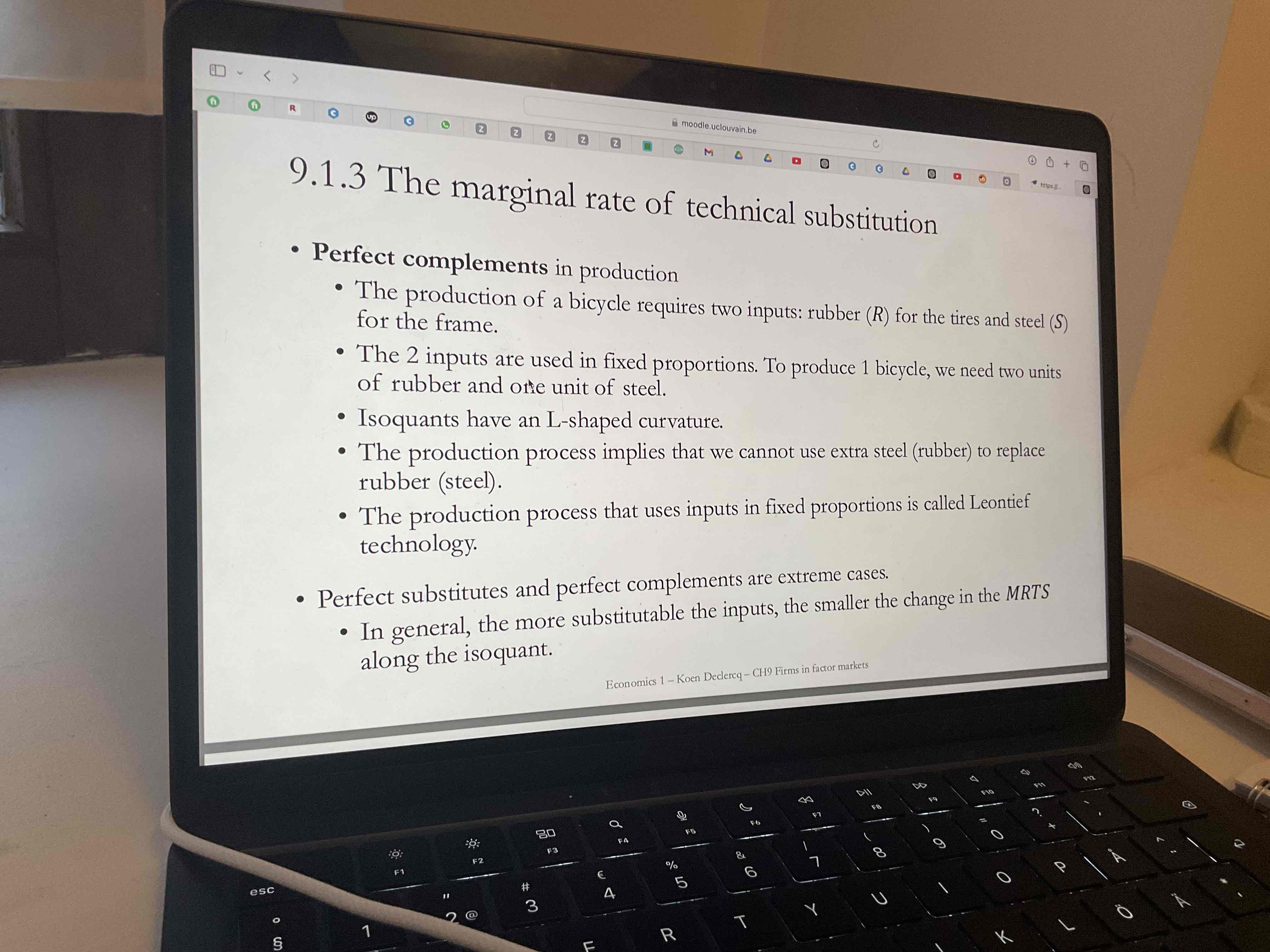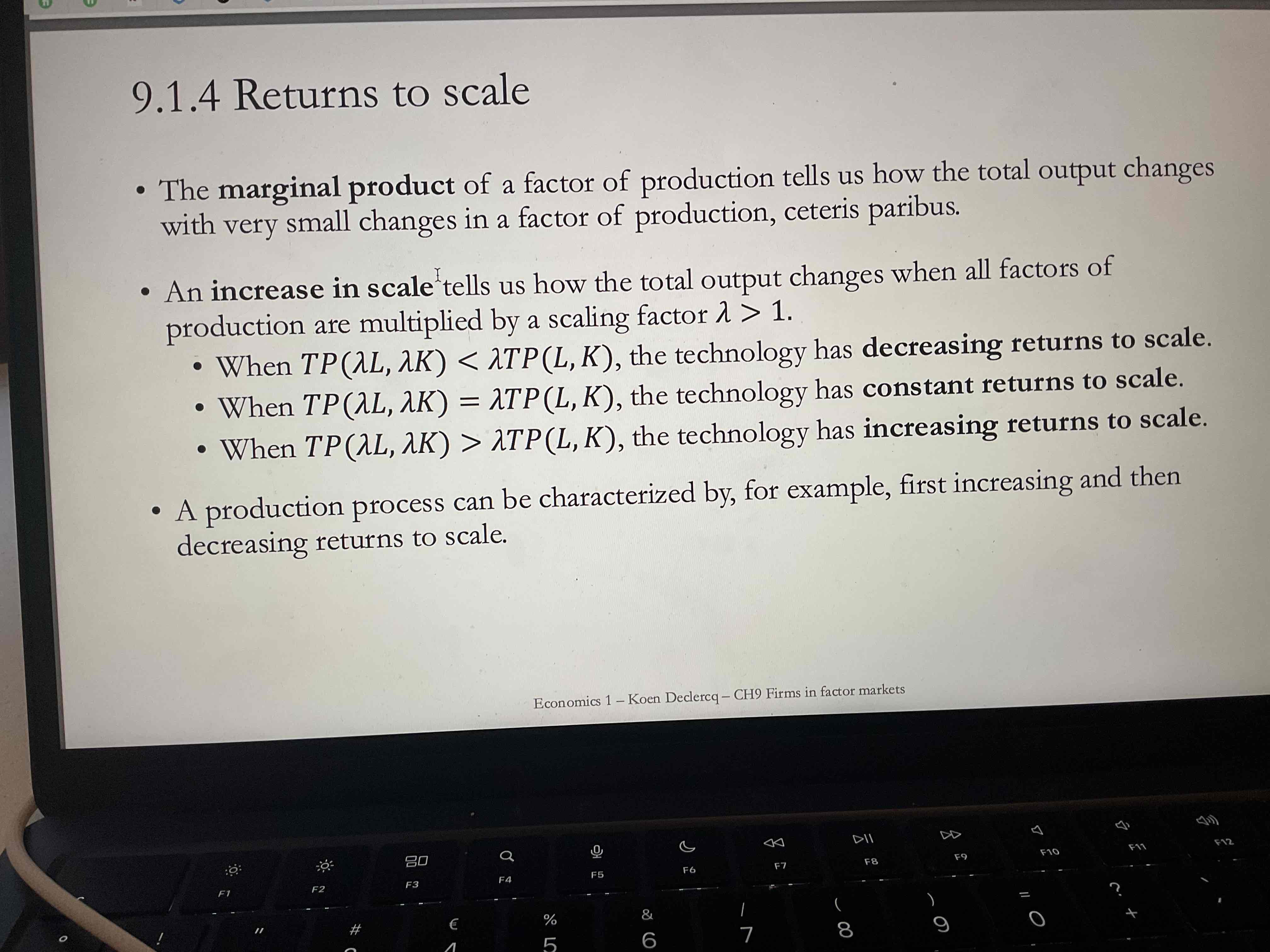Micro economics chapter 9 (Firms in factor markets)
1/21
There's no tags or description
Looks like no tags are added yet.
Name | Mastery | Learn | Test | Matching | Spaced |
|---|
No study sessions yet.
22 Terms
What two factors does the output of a firm depend on?
L (labour: number of workers ) and K (capital: number of machines)
What does a production function describe?
Maximum output that is technically possible as a function of the inputs is used.
What is the total production?
Total output for a given quantity of labour and capital.
What is an isoquant?
Describes all combinations of labour and capital that when used optimally lead to the same amount of output (combinations of inputs that lead to higher output lie on a higher isoquant)
What is the average product of labour?
Total product expressed per unit of labour. It is the slope of the line through the origin at the considered point on the total output curve graph.
What is the marginal product of labour?
The change in output for a very small change in quantity fo labour. It is the partial derivative of the production function with respect to the quantity of labour. It’s the slope of the tangent at the considered mid point on the total output curve.
What does the marginal product curve look like?

What is the marginal rate of technical substitution?
The marginal rate of technical substitution (MRTS) is the rate at which one input can be substituted for another while maintaining the same level of output, often represented as the slope of an isoquant.
How does the marginal rate of technical substitution work with perfect substitutes?

w does the marginal rate of technical substitution work with perfect Complements?

What does the marginal product of a factor of production tell us?
It indicates the additional output generated by using one more unit of that factor, helping to assess the efficiency and contribution of each input to production.
What does an increase in scale tell us?
How the total output changes when all factors of production are multiplied by a scaling factor.

What is the cobb-Douglas production function?
The Cobb-Douglas production function is a specific type of production function that defines the relationship between two or more inputs (typically labor and capital) and the amount of output produced, often expressed in the form Q = A * L^α * K^β, where A is total factor productivity, and α and β represent the output elasticities of labor and capital, respectively.
An isocost curve represents all combinations of inputs (such as labor and capital) that can be purchased with a given total cost. The slope of the isocost curve is determined by the relative prices of the inputs, illustrating the trade-offs between them when maintaining the same level of expenditure. For example, if the price of labor is lower than the price of capital, the curve will be steeper, indicating that a firm can afford more labor than capital for the same cost. Isocost lines are useful in production theory as they help firms identify optimal input combinations to minimize costs.
What is the capital-intensive mode of production on the isocost curve?
The capital-intensive mode of production refers to a method in which a larger proportion of capital is used relative to labor to produce goods. On the isocost curve, this mode is represented by points that show higher capital input for a given level of expenditure, indicating firms prioritize capital assets to achieve production efficiency.
The labour-intensive mode of production refers to a method in which a larger proportion of labour is used relative to capital to produce goods. On the isocost curve, this mode is represented by points that show higher labour input for a given level of expenditure, indicating firms prioritize labour to achieve production efficiency.
What is the substitution effect?
The substitution effect refers to the change in quantity demanded of a good due to a change in its price, leading consumers to substitute the good with alternatives that have become relatively cheaper, thereby impacting overall consumption patterns.
What is the long run total cost function?
The long run total cost function represents the total cost of production when all inputs can be varied, reflecting the lowest possible cost for producing a given level of output. It accounts for economies of scale and the optimal utilization of all resources over a long period.
Describe constant returns to scale
Production increases proportionally with proportional expansion of all factors of production
total cost evolve proportionally to the volume of production
The average and marginal costs are constant
Describe increasing returns to scale or economies of scale
Increasing returns to scale or economies of scale occur when the output increases by a greater percentage than the increase in inputs, leading to lower average costs per unit as production expands.
Explain decreasing returns to scale or diseconomies of scale
Decreasing returns to scale or diseconomies of scale occur when the output increases by a smaller percentage than the increase in inputs, leading to higher average costs per unit as production expands.